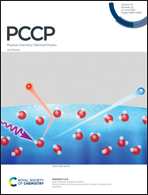Improved electrochemical properties of polypyrrole with cucurbit[6]uril via supramolecular interactions†
Abstract
A supramolecular polymer was developed through the encapsulation of polypyrrole by cucurbit[6]uril (PPy@Q[6]), which was employed as the electrode material to improve the capacitor ability of conductive polypyrrole. In the optimized ratio of 2 : 1 (CPPy : CQ[6]), the capacitor properties of the supramolecular material were evaluated, and a high specific capacitance of 414 F g−1 at 10 mV s−1 was obtained, which was 3.1 times higher than that of pure polypyrrole (132 F g−1). A comprehensive analysis suggested that the capacitance performances should be relevant to the component, surface area, and pore volume of the materials. The addition of 0.4 M Fe2(SO4)3 into the electrolyte provided a surprising specific capacitance of 3530 F g−1 on the cucurbituril-encapsulated polypyrrole electrode material, with a high energy density of 707 W h kg−1 at a power density of 32 000 W kg−1 and a current density of 8 A g−1. The 81.6% capacitance retention maintained after 1000 cycles revealed the acceptable cycling capacity of the proposed supramolecular supercapacitor system, which demonstrated good performance even at a low temperature of −20 °C.
![Graphical abstract: Improved electrochemical properties of polypyrrole with cucurbit[6]uril via supramolecular interactions](/en/Image/Get?imageInfo.ImageType=GA&imageInfo.ImageIdentifier.ManuscriptID=D2CP00321J&imageInfo.ImageIdentifier.Year=2022)


 Please wait while we load your content...
Please wait while we load your content...